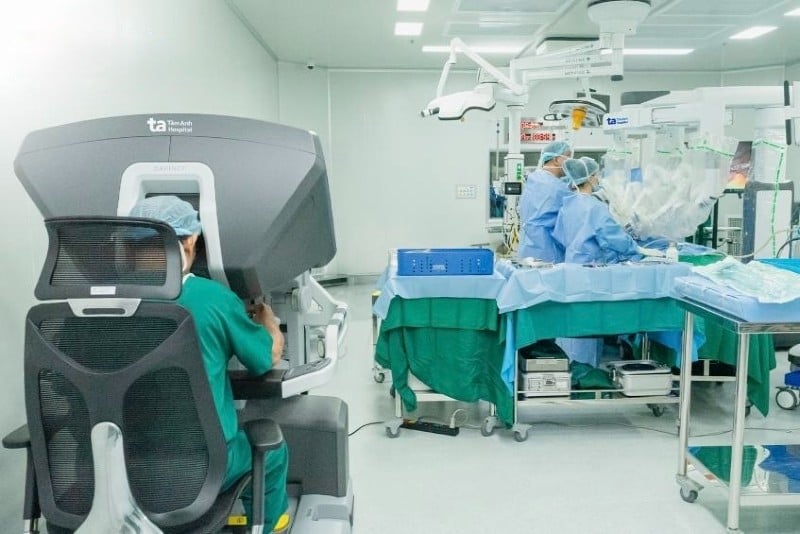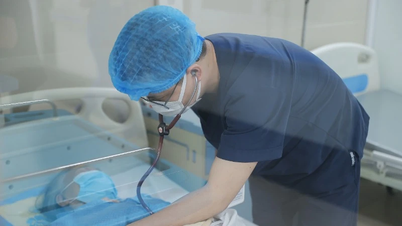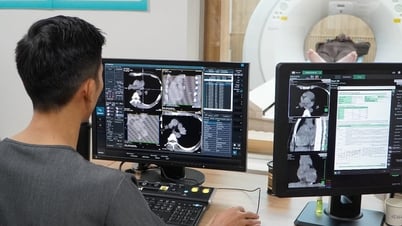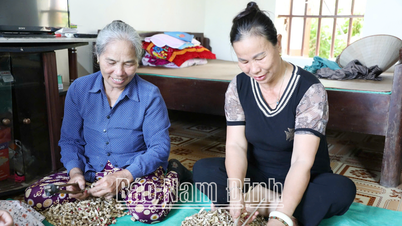Robotic surgery - a step forward to help Vietnamese medicine approach the world
What surprised patient Nguyen Van T., 49 years old, and his family was the left kidney tumor measuring 30mm in diameter that was discovered completely by chance during a routine health check-up.
 |
| The Da Vinci Xi robot is currently widely used in many specialties such as gastroenterology, hepatobiliary, gynecology, head and neck, cardiovascular, and thoracic. |
No pain, no fever, no other unusual symptoms, that's why he thought the doctor had given him the wrong results. But the truth is that the tumor had been silently growing in his body for a long time.
At the hospital, the results of a 1975-slice CT scan showed that the tumor was located at the lower pole of the back of the left kidney. After being advised by the doctor about three treatment methods - open surgery, laparoscopic surgery and robotic surgery, Mr. T. chose the most advanced method: robotic surgery. The advantages of this option are that the incision is small, less painful, safe, preserves the healthy kidney as much as possible and shortens the recovery time.
The surgery was performed by a team of experienced experts with the support of the Da Vinci Xi robot - the most modern robotic surgery system in Southeast Asia.
After only one hour, the tumor was completely removed, the entire left kidney was preserved. The patient recovered well after only 30 minutes of surgery. When the doctor came to visit the next morning, Mr. T. still could not believe that he had just undergone a major surgery.
“I was worried when I heard about the robotic surgery. But 24 hours after the surgery, I was able to walk again without much pain. It still seems unbelievable,” he shared with a relieved smile.
A sample of the tumor has been sent for biopsy. If the results show that the tumor is benign or low-grade malignant, the patient will not need further treatment. In the case of a high-grade malignant tumor, the doctor will continue to develop a treatment plan that best suits the patient's condition and stage of the disease.
According to doctors, laparoscopic surgery to preserve kidney tumors is a complex technique that requires high precision. Previously, with open surgery, patients often had to endure a scar up to 12cm long, with a high risk of bleeding, infection and complications. But with the support of the Da Vinci Xi robotic system, advanced surgical technology from the US, things have changed.
Robots help with minimally invasive surgery, preserving healthy tissue, reducing pain, recovering quickly and minimizing complications. The robotic arms simulate human wrist movements with up to 540-degree rotation, helping doctors accurately access deep, narrow areas that are difficult to reach with traditional endoscopy methods such as the pelvic or retroperitoneal areas.
Not only in urology, the Da Vinci Xi robot is now widely used in many specialties such as gastroenterology, hepatobiliary, gynecology, head and neck, cardiovascular, thoracic... In Vietnam, this is one of the most modern robotic surgery systems, helping to bring the country's medicine up to date with advanced countries in the world.
Associate Professor, Dr. Vu Le Chuyen, Tam Anh General Hospital, Ho Chi Minh City, emphasized that the application of robots is not only a technical step forward, but also an affirmation that Vietnamese medicine is completely capable of mastering the most complex technologies in the world.
We believe that with Da Vinci Xi, the urological surgery industry in particular and Vietnamese surgery in general will have more successful, safe and less risky surgeries, thereby improving the quality of life for patients.
Nowadays, robotic surgery in Vietnam is no longer a strange thing. On the contrary, it is gradually becoming an inevitable trend in treatment, especially for the elderly or patients with underlying diseases, those who need less painful methods, quick recovery, and minimize complications.
More than 14.2 million surgeries worldwide have been performed using the Da Vinci robotic system, which is recognized by the FDA (USA) as the “gold standard” of minimally invasive surgery.
The presence of this technology in Vietnam is the clearest proof of the remarkable development of domestic medicine. No longer a follower, Vietnam is now gradually rising to become a reliable destination in international medical tourism - where patients not only find faith in life, but are also treated by the steady hands and brave intelligence of the Vietnamese medical team.
Women with cervical cancer give birth safely thanks to new treatment regimen
For the first time in Vietnam, a pregnant woman at 36 weeks with cervical cancer has safely given birth thanks to a modern neoadjuvant chemotherapy regimen. The special surgery was performed at the Central Obstetrics Hospital, bringing new hope to pregnant women who are unfortunately suffering from cancer.
Pregnant woman T., 42 years old, was diagnosed with stage 1B3 cervical cancer when she was 26 weeks pregnant. Faced with a life-or-death situation, she faced a difficult choice between continuing the pregnancy or timely cancer treatment to save her life.
However, thanks to the advice and application of neoadjuvant chemotherapy treatment regimen by doctors at the Central Obstetrics Hospital, both the mother and the fetus are safely protected throughout the treatment process. This is a modern method that helps control tumor progression while still ensuring fetal development.
Under the strict supervision of a team of specialists, the fetus developed steadily for 10 weeks after chemotherapy. When the fetus was 36 weeks old and qualified for safe intervention, the medical team led by Dr. Nguyen Van Thang - Head of the Department of Gynecological Oncology - performed a double surgery: cesarean section combined with radical hysterectomy and bilateral lymph node dissection to treat cancer.
According to Dr. Thang, the biggest difficulty of the surgery was the risk of severe bleeding due to pregnancy causing the uterine blood vessels to proliferate. The surgery was performed with the coordination of many specialties, along with modern surgical techniques to ensure maximum safety for mother and baby.
After surgery, the baby boy was born healthy, the mother recovered well and continued to be monitored and treated according to specialized regimen.
In the past, in similar cases, early termination of pregnancy was almost a mandatory option to prioritize cancer treatment. However, thanks to the remarkable advances of modern medicine, especially in updating and implementing new treatment regimens, doctors have been able to simultaneously maintain pregnancy and effectively control cancer.
Sharing about this case, Dr. Nguyen Van Thang emphasized: “If cervical cancer is detected early, it can be completely controlled and treated well. Therefore, women need to proactively have regular gynecological examinations, cervical cancer screening and HPV vaccination to protect their own reproductive health.”
Beware of potential brain damage after head trauma
After a patient was diagnosed with a brain hematoma two months after a traffic accident, the Central Hospital for Tropical Diseases recommends: People who have suffered a head injury, if they experience symptoms such as prolonged headache, hemiplegia, blurred vision, etc., should go to a medical facility for timely examination to avoid missing dangerous brain injuries.
Information from the Central Hospital for Tropical Diseases said that they had just successfully performed surgery on Mr. NXC (40 years old, Hanoi ) - a person with chronic subdural hematoma, at risk of right hemiplegia after a motorbike accident.
About two months ago, Mr. C. fell off his motorbike and his head (even though he was wearing a helmet) hit the back of a truck. At that time, he received first aid and a CT scan of his brain, but no injuries were found, only minor scratches on his arms and legs.
However, for nearly a month now, he has been suffering from persistent headaches, especially in the last two weeks when he has experienced blurred vision and weakness on the right side of his body. When he went to the Central Hospital for Tropical Diseases for examination, a CT scan revealed a chronic subdural hematoma in the left hemisphere of the brain, measuring 3.2 cm, compressing the brain parenchyma.
Master, Doctor Nguyen Quang Thanh, a specialist in cranial neurosurgery at the hospital, said that chronic subdural hematoma is a condition that can progress silently for several weeks to several months after the injury. Common symptoms include headache, weakness or paralysis of one side of the body, difficulty speaking, dizziness, nausea…”
After consultation, the doctors decided to perform the surgery using awake brain surgery - a modern technique that does not require general anesthesia. During the surgery, the patient remains awake and can communicate with the doctor, helping the surgeon closely monitor neurological function, minimize the risk of invasion of healthy tissue, and preserve maximum mobility and cognition.
One day after surgery, Mr. C. was able to eat, talk, and move normally, with only mild pain in the surgical area. Dr. Thanh added: Awake brain surgery is indicated in cases of chronic subdural hematoma, external ventricular drainage, or brain tumor surgery in important functional areas. This method effectively removes hematomas while limiting neurological sequelae, contributing to improving the patient's recovery ability.
Source: https://baodautu.vn/tin-moi-y-te-ngay-145-y-hoc-viet-nam-tiem-can-trinh-do-quoc-te-nho-robot-phau-thuat-d283542.html





![[Photo] General Secretary To Lam works with the Central Inspection Commission](https://vphoto.vietnam.vn/thumb/1200x675/vietnam/resource/IMAGE/2025/5/22/54820e91fd124c4cb691961718c4ee5d)

![[Photo] Prime Minister Pham Minh Chinh chairs the Government's special meeting on law-making in May](https://vphoto.vietnam.vn/thumb/1200x675/vietnam/resource/IMAGE/2025/5/22/1c880aae96fd4e0894abc47a46fe19ba)























































































Comment (0)